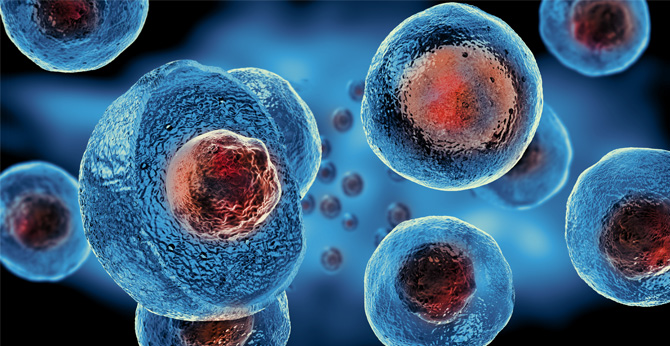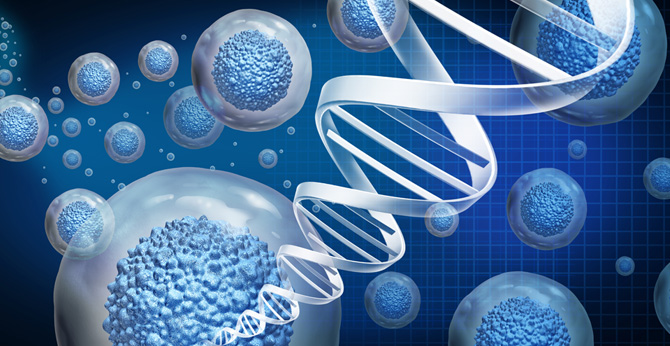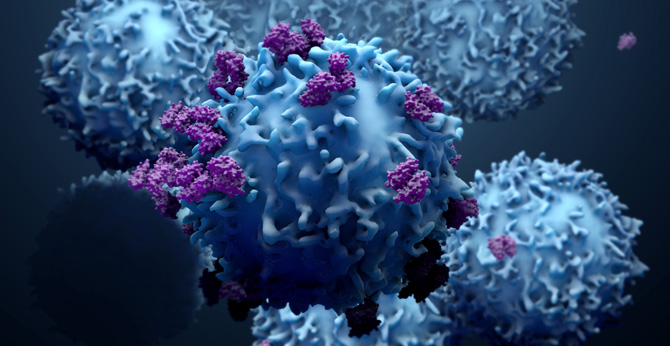All products and services are For Research Use Only and CANNOT be used in the treatment or diagnosis of disease.
Creative Biolabs provides extensive anti-CD33 related CAR products and services for global customers. If you have any technical questions about CAR design and construction, our team is pleased to get the job done.
CD33, known as siglec-3, is a type I transmembrane protein expressed on the myeloid lineage cells. CD33 plays an important role in many biological processes, such as adhesion processes and apoptosis induction. What is more, it is associated with many diseases, especially acute myeloid leukemia (AML). Targeting CD33 CART therapy is a promising treatment for AML.
 Fig.1 Schematic diagram of CD33 signaling pathway.1
Fig.1 Schematic diagram of CD33 signaling pathway.1
Anti-CD33 CAR Cell Proliferation Test
Expansion capability serves as an important index to evaluate CAR cell function. At Creative Biolabs, we provide appropriate methods to measure CAR cells, such as time-lapsed amplification detection.
 Fig.2 Time-lapsed amplification detection of 2nd CD33 CAR-transduced NK cells in the presence of IL-2 and IL-15.2
Fig.2 Time-lapsed amplification detection of 2nd CD33 CAR-transduced NK cells in the presence of IL-2 and IL-15.2
Anti-CD33 CAR Cell Expression Test
For the CAR expression test, Creative Biolabs provides several sensitive CAR detection reagents for flow cytometry applications. Regarding the CD33 target, we provide effective tools for detecting anti-CD33 CAR expression, such as APC labeled or biotinylated CD33 CAR detection reagents, as well as some anti-G4S linker antibodies. Meanwhile, we also provide a one-stop CAR expression detection service for various CAR cells.
 Fig.3 Flow cytometry analysis to evaluate CAR expression of anti-CD33 CAR-NK cells after transgene transfer 12 days.2
Fig.3 Flow cytometry analysis to evaluate CAR expression of anti-CD33 CAR-NK cells after transgene transfer 12 days.2
Anti-CD33 CAR Cell Cytokine Release Test
For cytokine analysis in CART development, we provide various techniques to meet customers' special needs, such as economical ELISA to detect limited cytokine types, convenient multiplex cytokine array to measure a wide range of cytokines. In addition, we accept not only limited to cell supernatants, such as animal serum and other samples are also acceptable to detect.
 Fig.4 Cytokine analysis (GM-CSF, INF-γ, MIP-1α) of blood serum from OCI-AML2 engrafted NSG-SGM3 mice with the treatment of CD33 CAR-NK cells.2
Fig.4 Cytokine analysis (GM-CSF, INF-γ, MIP-1α) of blood serum from OCI-AML2 engrafted NSG-SGM3 mice with the treatment of CD33 CAR-NK cells.2
Anti-CD33 CAR Cell In Vitro Cytotoxicity Assay
For in vitro anti-tumor evaluation of CAR cells, Creative Biolabs specializes in providing advanced techniques to aid in global customers' CAR cell development. In addition to some classical methods, such as end-point LDH cytotoxicity detection, we have developed more sensitive approaches, such as in situ hybridization fluorescence detection, and real-time dynamic fluorescence monitoring to support CART development.
 Fig.5 Anti-tumor activity of anti-CD33 CAR-NK cells against OCI-AML2 target cells by dynamic fluorescence monitoring. OCI-AML2 target cells were labeled GFP and co-cultured with CAR-NK cells, which fluorescence was detected by IncuCyte imaging system.2
Fig.5 Anti-tumor activity of anti-CD33 CAR-NK cells against OCI-AML2 target cells by dynamic fluorescence monitoring. OCI-AML2 target cells were labeled GFP and co-cultured with CAR-NK cells, which fluorescence was detected by IncuCyte imaging system.2
Anti-CD33 CAR Cell Therapy Animal Models
An appropriate animal model will do more with less expense for CART development. Leveraging our years of experience in CART fields, our team of experts will tailor the in vivo model experiment design according to clients' special needs.
 Fig.6 Schematic of the anti-CD33 CAR cell therapy mouse model design.2
Fig.6 Schematic of the anti-CD33 CAR cell therapy mouse model design.2
Efficacy Test of Anti-CD33 CAR Cell
For in vivo efficacy tests of CAR cells, we provide a one-stop comprehensive evaluation service to aid in clients; projects. Meanwhile, we also provide various toxicological assessment services, such as tumorigenicity studies, on-target and off-target toxicity studies.
 Fig.7 In vivo potency of CD33 CAR-NK cells in OCI-AML2-Luc engrafted NSG-SGM3 mice by total flux analysis and BLI imaging.2
Fig.7 In vivo potency of CD33 CAR-NK cells in OCI-AML2-Luc engrafted NSG-SGM3 mice by total flux analysis and BLI imaging.2
References
 Loading...
Loading...
| CAT | Product Name | Target Species | Antibody Clone | Antibody Host | Receptor Construction | Vector Type | Targeting Cell Type | CAR Vector Type | Inquiry & Datasheet |
| XS-0922-ZP836 | Anti-CD33 (C-18) h(CD28-CD3ζ) CAR, pCDCAR1 | Mouse | C-18 | Humanized | scFv-CD28-CD3ζ | Lentiviral vector | T cell | ||
| XS-0922-ZP837 | Anti-CD33 (C-19) h(CD28-CD3ζ) CAR, pCDCAR1 | Mouse | C-19 | Humanized | scFv-CD28-CD3ζ | Lentiviral vector | T cell | ||
| XS-0922-ZP838 | Anti-CD33 (C-20) h(CD28-CD3ζ) CAR, pCDCAR1 | Mouse | C-20 | Humanized | scFv-CD28-CD3ζ | Lentiviral vector | T cell | ||
| XS-0922-ZP839 | Anti-CD33 (C-21) h(CD28-CD3ζ) CAR, pCDCAR1 | Mouse | C-21 | Humanized | scFv-CD28-CD3ζ | Lentiviral vector | T cell | ||
| XS-0922-ZP1146 | Anti-CD33 (C-18) h(4-1BB-CD3ζ) CAR, pCDCAR1 | Mouse | C-18 | Humanized | scFv-4-1BB-CD3ζ | Lentiviral vector | T cell | ||
| XS-0922-ZP1147 | Anti-CD33 (C-19) h(4-1BB-CD3ζ) CAR, pCDCAR1 | Mouse | C-19 | Humanized | scFv-4-1BB-CD3ζ | Lentiviral vector | T cell | ||
| XS-0922-ZP1148 | Anti-CD33 (C-20) h(4-1BB-CD3ζ) CAR, pCDCAR1 | Mouse | C-20 | Humanized | scFv-4-1BB-CD3ζ | Lentiviral vector | T cell | ||
| XS-0922-ZP1149 | Anti-CD33 (C-21) h(4-1BB-CD3ζ) CAR, pCDCAR1 | Mouse | C-21 | Humanized | scFv-4-1BB-CD3ζ | Lentiviral vector | T cell | ||
| XS-0922-ZP1320 | Anti-CD33 (6A11-1) h(4-1BB-CD3ζ) CAR, pCDCAR1 | Human | 6A11-1 | Mouse | scFv-4-1BB-CD3ζ | Lentiviral vector | T cell | ||
| XS-0922-ZP1321 | Anti-CD33 (27A3-1) h(4-1BB-CD3ζ) CAR, pCDCAR1 | Human | 27A3-1 | Mouse | scFv-4-1BB-CD3ζ | Lentiviral vector | T cell | ||
| XS-1122-YF1963 | Anti-CD33 TCR-ABR (scFv-TCRβ, XW-123) CAR Plasmid, pCDCAR1 | Human | XW-123 | Human | scFv-TCRβ | Lentiviral vector | T Cell | ||
| XS-1122-YF1964 | Anti-CD33 TCR-ABR (scFv-TCRβ, XW-124) CAR Plasmid, pCDCAR1 | Human | XW-124 | Humanized | scFv-TCRβ | Lentiviral vector | T Cell | ||
| XS-1122-YF1965 | Anti-CD33 TCR-ABR (scFv-TCRβ, XW-125) CAR Plasmid, pCDCAR1 | Human | XW-125 | Humanized | scFv-TCRβ | Lentiviral vector | T Cell | ||
| XS-1122-YF1966 | Anti-CD33 TCR-ABR (scFv-TCRβ, XW-126) CAR Plasmid, pCDCAR1 | Human | XW-126 | Humanized | scFv-TCRβ | Lentiviral vector | T Cell | ||
| XS-1122-YF1967 | Anti-CD33 TCR-ABR (scFv-TCRβ, XW-127) CAR Plasmid, pCDCAR1 | Mouse | XW-127 | Humanized | scFv-TCRβ | Lentiviral vector | T Cell | ||
| XS-1122-YF1968 | Anti-CD33 TCR-ABR (scFv-TCRβ, XW-128) CAR Plasmid, pCDCAR1 | Mouse | XW-128 | Humanized | scFv-TCRβ | Lentiviral vector | T Cell | ||
| XS-1122-YF1969 | Anti-CD33 TCR-ABR (scFv-TCRβ, XW-129) CAR Plasmid, pCDCAR1 | Mouse | XW-129 | Humanized | scFv-TCRβ | Lentiviral vector | T Cell | ||
| XS-1122-YF1970 | Anti-CD33 TCR-ABR (scFv-TCRβ, XW-130) CAR Plasmid, pCDCAR1 | Mouse | XW-130 | Humanized | scFv-TCRβ | Lentiviral vector | T Cell | ||
| XS-1122-YF1971 | Anti-CD33 TCR-ABR (scFv-TCRβ, XW-131) CAR Plasmid, pCDCAR1 | Human | XW-131 | Mouse | scFv-TCRβ | Lentiviral vector | T Cell | ||
| XS-1122-YF1972 | Anti-CD33 TCR-ABR (scFv-TCRβ, XW-132) CAR Plasmid, pCDCAR1 | Human | XW-132 | Mouse | scFv-TCRβ | Lentiviral vector | T Cell | ||
| XS-0823-LX17 | Anti-hCD33 (MAB) ICD(CD28-OX40-CD3ζ) CAR-MA, pAd5f35 Vector | Human | MAB | Adenoviral vectors |
 NEWSLETTER
NEWSLETTER
The latest newsletter to introduce the latest breaking information, our site updates, field and other scientific news, important events, and insights from industry leaders
LEARN MORE NEWSLETTER NEW SOLUTION
NEW SOLUTION
CellRapeutics™ In Vivo Cell Engineering: One-stop in vivo T/B/NK cell and macrophage engineering services covering vectors construction to function verification.
LEARN MORE SOLUTION NOVEL TECHNOLOGY
NOVEL TECHNOLOGY
Silence™ CAR-T Cell: A novel platform to enhance CAR-T cell immunotherapy by combining RNAi technology to suppress genes that may impede CAR functionality.
LEARN MORE NOVEL TECHNOLOGY NEW SOLUTION
NEW SOLUTION
Canine CAR-T Therapy Development: From early target discovery, CAR design and construction, cell culture, and transfection, to in vitro and in vivo function validation.
LEARN MORE SOLUTION